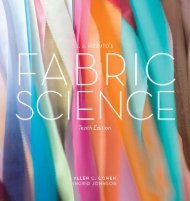Visual Merchandising Display - Fairchild Books
Visual Merchandising Display - Fairchild Books
Visual Merchandising Display - Fairchild Books
You also want an ePaper? Increase the reach of your titles
YUMPU automatically turns print PDFs into web optimized ePapers that Google loves.
Figure 4.11 Bee lights, neon, and other novelty lights can be added to a lighting plan for assorted effects. Here, a green neon strip runs<br />
just under the ceiling to effect a tinted wall wash and play up the brick textured wall in the men’s jeans area. In addition, neon signage<br />
is decoratively employed throughout this store to designate the shops within the shop and to highlight them with color. River Island,<br />
Amsterdam. Design: Dalziel & Pow, London.<br />
to the merchandise. With the great variations in state and<br />
city codes, the ever-increasing desire for an upscale image,<br />
and the specialization of areas on the selling floor, a trained<br />
lighting specialist is required to perform the lighting magic<br />
needed to bring the store to life.<br />
David A. Mintz, a lighting authority, has lighted more<br />
than 40 million square feet of retail space for many of this<br />
country’s largest department and specialty stores. According<br />
to Mintz, “Perception is what the lighting actually enhances.<br />
It is the customer’s perceived attitude toward lighting and<br />
merchandise.” Lower levels of illumination usually suggest to<br />
the upscale customer better or more expensive merchandise.<br />
Retailers too, feel that incandescent light means that softer,<br />
finer merchandise is being offered. However, a light level that<br />
is too low may not necessarily make a shop look elegant and<br />
exclusive; it might just look dull and gloomy. Mintz personally<br />
opts for an “upbeat, brighter rather than duller luminosity in<br />
44<br />
P a r t 1 : G e t t i n G S ta r t e d — V i S u a l M e r c h a n d i S i n G a n d d i S P l ay B a S i c S<br />
the retail ambience.” In low light, people tend to whisper in<br />
hushed tones and move as though they were in a museum. The<br />
merchandise becomes untouchable and remote. The shopper<br />
can be inhibited, and that’s not good for selling.<br />
Properly lighting a store requires a palette of lamps<br />
and light sources to create the total effect. It requires incandescent<br />
plus fluorescent lights, tungsten-halogen lamps,<br />
and even novelties, like neon strips. According to Mintz,<br />
there is no single ideal or best lighting design for a store.<br />
There are too many variables: the changing feeling, texture,<br />
and look of the merchandise; the location of a department<br />
and what type of merchandise it carries; how the adjacent<br />
areas or shops relate to one another. The lighting design is<br />
also affected by neighboring establishments (especially in<br />
malls), the nature of the clientele and their perceptions, the<br />
colors and textures that comprise the decorative scheme,<br />
and the height and type of ceiling.













